This weekends game at the BayArena was one which looked reasonably how it was expected to. Freiburg, currently flying in the Bundesliga, are renowned for their out of possession play and defensive solidity, while Bayer Leverkusen boast one of the highest average possession percentages of any team in Europe’s top five leagues, and Peter Bosz’s sides are known for their positional play, as well as their poor ability to prevent counter-attacks. In this tactical analysis, I will look at Freiburg’s numerous setup changes within the game, how these limited Leverkusen, and how Leverkusen were able to exploit one particular weakness within Freiburg’s system but were unable to capitalise.
Lineups
Leverkusen lined up in their usual 4-2-3-1, which showed itself as all the usual variations on a 4-3-3, depending on the positioning of the central midfielders. Kerem Demirbay would drop to receive the ball, with the two midfielders usually looking to receive progressive passes from the centre backs, or two midfielders could drop to form the 4-2-3-1. Freiburg meanwhile rotated throughout the game between formations, as I will cover in this analysis.
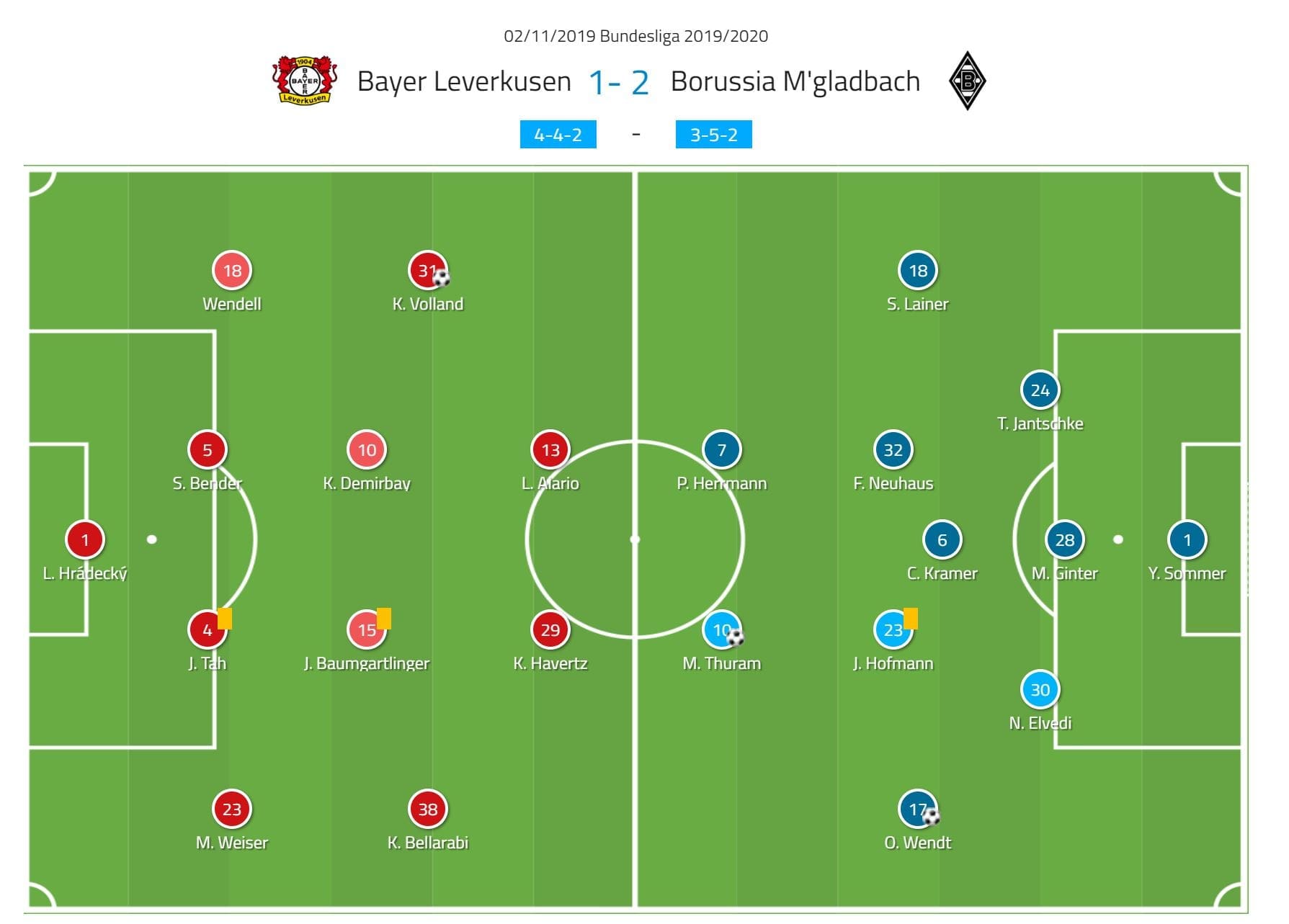
Freiburg’s gameplan
As mentioned Freiburg’s gameplan and the general pattern of the game was fairly predictable, with Leverkusen having 70% possession. Freiburg were therefore expected to make the most of set pieces and whatever counter-attacking opportunities they could create with limited players high up the pitch.
Freiburg’s gameplan became a success very quickly when in the fifth minute they were able to exploit Leverkusen’s man-marking approach from corners. In a pretty basic routine, Freiburg used diversion runners that ran to the near post in order to create space at the far post. As we can see below these runners were followed by their man markers, while the target player feints acting as a blocker, which leaves his marker flat-footed expecting little movement from the attacker.

The markers then followed their runners, and the target player ran towards the back post, with a clear run thanks to his flat-footed marker. The delivery is perfect and Lucas Höler is free to head Freiburg into the lead. This is just one of many examples of how because man-marking is completely reliant on the movement of the opposition, it can be easily manipulated by the opposition.

Freiburg’s initial back five and Leverkusen exploit
Freiburg initially used a back five, and eventually reverted back to this later in the game. This allowed them to deal with Leverkusen’s usual 2-4-4 formation, and allowed for maximum coverage across the width of the pitch, as we can see below. Freiburg used this with a mid-block usually, occasionally reverting to a deep block. This allowed for coverage along their defensive line but left more gaps in midfield areas for Leverkusen to exploit using their signature progressive passes.

With Freiburg using a 5-2-3 usually when out of possession, Freiburg struggled in wide areas and despite having a back five were quite easily stretched by passes to the full-backs, which due to Leverkusen’s central overloads allowed them to outnumber Freiburg’s wing-backs and cause problems, as we can see in these examples below.
The problem came in deeper areas, where Freiburg’s narrow shape allowed for these wide areas to be overloaded and forced the wing back to press. We can see below the wing-back presses, which forces a shuffle across and for the centre back to take up the conventional full-back position. This leaves a large space between the centre backs, which Leverkusen were able to exploit at times. In this situation, the midfielder in front of the space is able to prevent a pass being played.

The following diagram sums up Freiburg’s slight issues. The front three would press the centre backs when they progressed into their half and would try to remain narrow in order to limit central passes. This meant that if the pass went wide, the wing-back would be forced to press.
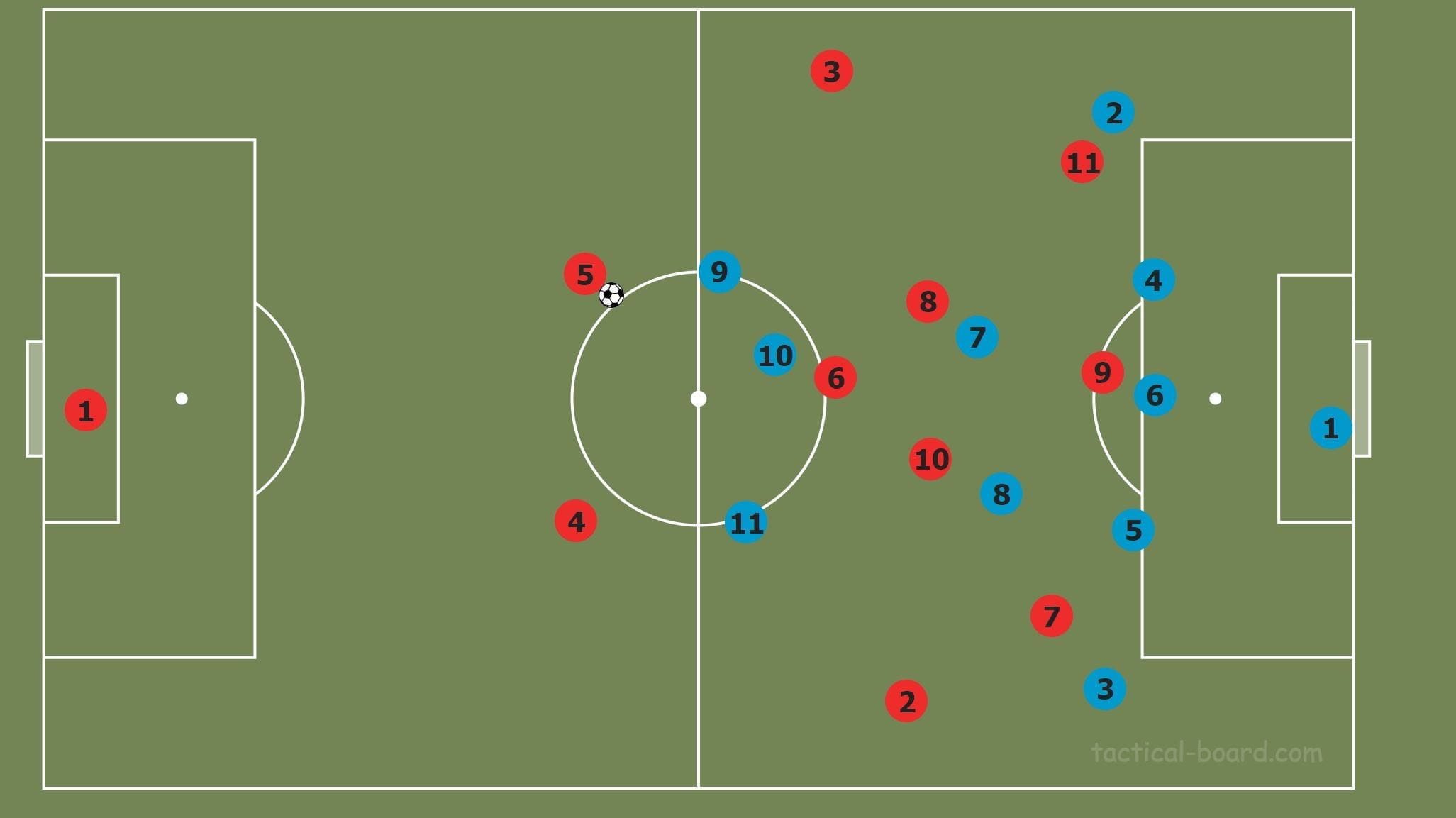
As mentioned this opened up this space, between two of the three centre backs, and so Leverkusen were able to progress through this pattern of play.
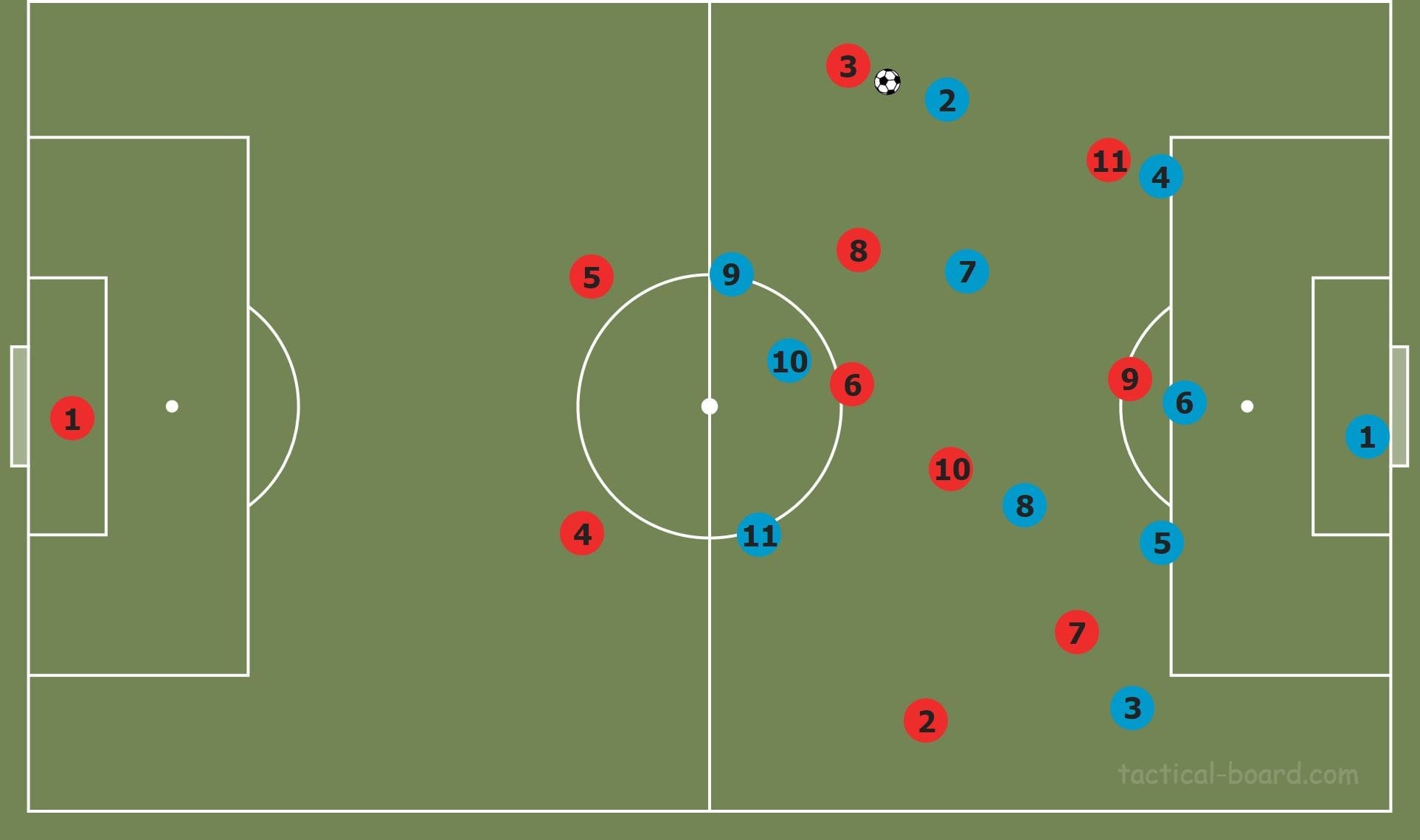
Here higher up the pitch, Jonathan Schmid pushes up and presses the full-back, with the forwards unable to put pressure on the wide player quickly enough. With the passing lane inside not cut off, Leverkusen are able to easily progress.

Because of how high on the pitch the press took place, Freiburg do not have many men committed back, and so the space the wing-back leaves can be exploited and Leverkusen should score.

In this final example, Leverkusen are able to progress the ball in the same pattern, and Moussa Diaby then gets into a race with Jonathan Schmid to run into the space left when pressing. The centre back again tries to cover this space left by the pressing wing-back, and the space between the centre backs opens up.
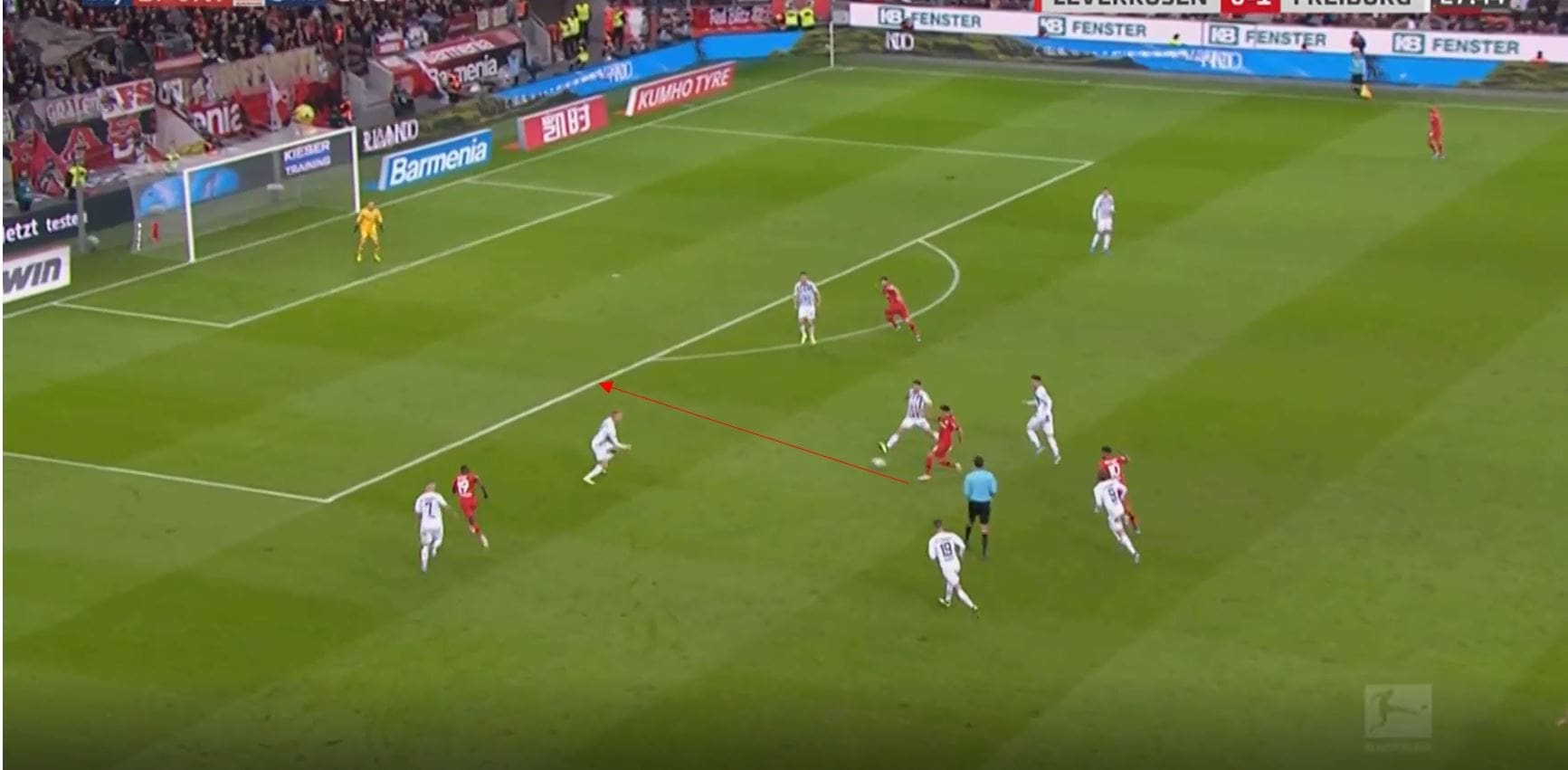
Switch to a 4-3-3
Midway through the first half, Freiburg seemed to switch to a 4-3-3, with Robin Koch stepping in to play the number six role. Freiburg’s central striker also dropped, forming an almost diamond formation in the middle as seen below. Freiburg here looked to protect the central area of the pitch, but here had more midfield coverage to press Leverkusen with, especially if they entered these wide areas. The wing-backs, now full-backs, were now able to take up a more defensive position and didn’t have to push high when pressing, which limited the space highlighted earlier.
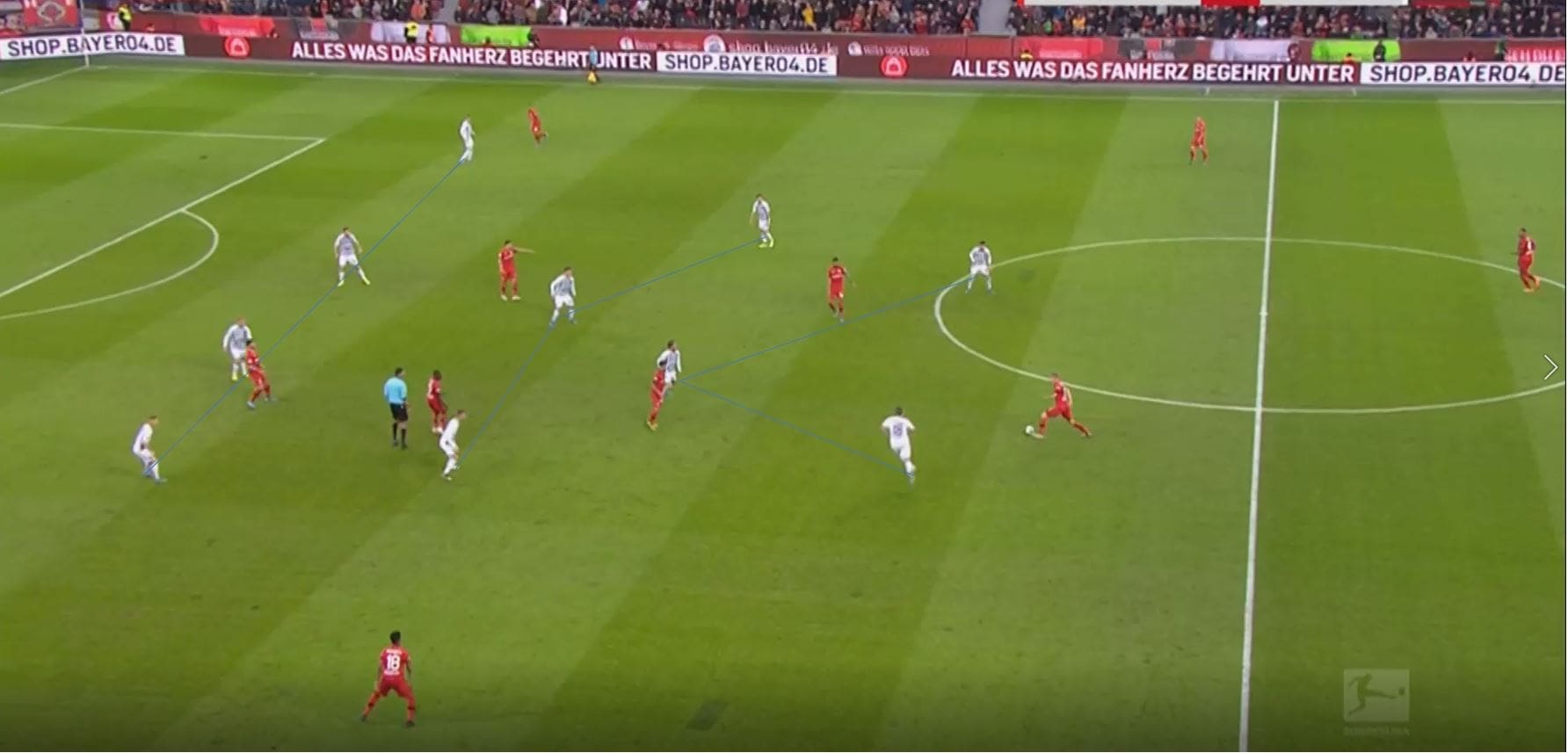
We can see here the 4-3-3 in action again, with a mid-block fairly relaxed press. With the central midfielders now available to press the full-backs, Leverkusen often tried to play through the middle more often, where Freiburg’s centre backs were aggressive in the tackle.

Leverkusen look to lure a press
In the second half, Freiburg began to press slightly higher, with their front three pressing the backline while the midfielders reluctantly stepped up. Leverkusen looked to take advantage of this by luring a press from Freiburg in order to then go over it, as we can see in the examples below.
On a few occasions such as the one below, Freiburg seemed unsure on whether to press or not, which led to no immediate pressure being put on the ball despite a high positioning of the midfield. Therefore, Leverkusen chose to go over the midfield when they could.

We can see below that when the press is lured, Leverkusen are able to receive in space, and have players quick enough in transition that they can try to quickly capitalise from these situations. Diaby is able to get through and have a goal-scoring chance from Leverkusen receiving the ball in this space highlighted, but as became the theme of the afternoon, they couldn’t finish the opportunity.

Conclusion
The xG total of 3.58 to 0.71 in Leverkusen’s favour tells a brief story of the game, and overall I wasn’t impressed with Freiburg’s set up and performance. As you can probably tell from this analysis, their defensive tactics switched frequently within the game, and as a result, their fluidity and understanding of how to defend within that system seemed to fade at times. Leverkusen should have took advantage of the numerous chances they had, and Diaby looked a welcome change to the sometimes robotic, slow machine that can be Leverkusen’s positional play, and his performance was rewarded with a goal, although he probably should have got more.

If you love tactical analysis, then you’ll love the digital magazines from totalfootballanalysis.com – a guaranteed 100+ pages of pure tactical analysis covering topics from the Premier League, Serie A, La Liga, Bundesliga and many, many more. Buy your copy of the November issue for just ₤4.99 here





Comments